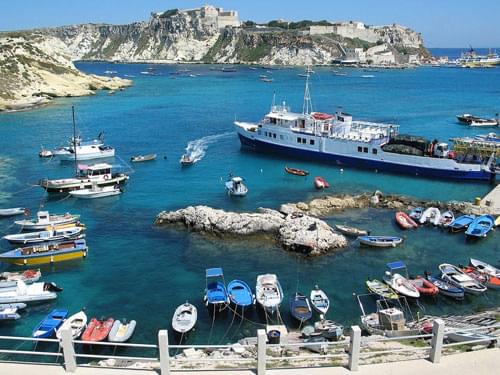
The Tremiti islands are located in the Adriatic sea, off the northern coast of the province of Foggia in Puglia. The archipelago consists of five small islands: San Dòmino, San Nicola, Cretaccio, Capraia and Pianosa, and are part of the Gargano National Park. Their solitude and the clear blue water that surrounds them attracts more than 100,000 visitors a year who arrive on ferries from the ports of: Termoli, Foggia, Vieste, Rodi Garganico and Capoiale.
The largest island is San Dòmino. It is 2,600 metres long and 1,700 metres wide with a total area of just over 2 square kilometres.

The highest point is just over 100 metres. It is the nearest island to the Gargano Peninsula and is the main tourist attraction. It has a population of around 250 people.
450 metres to the north east lies the island of San Nicola. 1,600 metres long and 450 metres wide, it has a total area of just under half a square kilometre. The highest point is 75 metres. It has a population of around 150 people.

The island of Cretaccio, lying between San Dòmino and San Nicola, is little more than a rock and is uninhabited.

The island of Capraia, named after its population of wild goats, is the same size as San Nicola but is uninhabited.

The island of Pianosa lies away from the main group, 20 nautical miles from the Italian coast. It is 700 metres long, 250 metres wide and only 15 metres high. It has a total area of only 13 hectares (32 acres) and is also uninhabited.

One explanation of the name, 'Tremiti', is that it refers to the frequent earth tremors and the islands' long history of earthquakes, although another explanation is that it refers to the Greek, 'Trimeros', meaning 'Tree Islands'. Whatever the origins of the name, the islands have had a very long history and have been inhabited since the 4th century BC.
An abbey, Santa Maria a Mare (Holy Mary on the Sea), was established on the island of San Nicola around the 9th century by Benedictine monks. Politics and piracy led to the decline and eventual destruction of the abbey in the 13th century. In the 15th century, the abbey was restored and fortified to the extent that it withstood an attack by the Ottomans in 1567.
During the 18th century, the islands became a penal colony under the king of Sicily, Ferdinand IV. Mussolini also used the islands as a prison camp when he deported hundreds of homosexuals and interned them there in the period before the second world war.
In 2012, the islands became involved in scandal when the local government tried to sell off some of the land for several millions of euros. The locals were outraged, but it all came to nothing as there were no bidders!
So, for now, the Tremiti islands continue to be a favourite destination for those holiday makers who have discovered them...

More Details